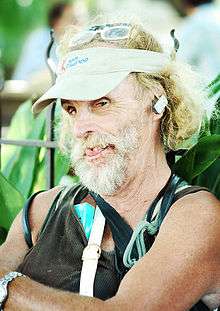Street people

Street people are people who live a public life on the streets of a city.[1][2] Street people are frequently homeless, sometimes mentally ill, and often have a transient lifestyle. Certain neighborhoods, especially those in neighborhoods near universities, such as Telegraph Avenue in Berkeley, California, The Ave in Seattle, Washington, or the Pearl Street Mall in Boulder, Colorado often host street people. They may also frequent bohemian commercial districts such as Colfax Avenue in Denver. Individual street people may be familiar figures to the entire community.
Well-known street people
Examples of well-known street people are José María López Lledín who lived a public life on the streets of Havana during the 1950s, Mr. Butch of Boston, Leslie Cochran of Austin, Juan of Seattle, or Louis Thomas Hardin ("Moondog") who was a street musician, inventor, and later homeless person in the 1940s through to 1970s in New York City.
Character of street people
Contemporary street people in the United States include hippies, some of whom may be beggars who often ask for spare change on the streets;[3] bag ladies who often have all their possessions in a shopping cart which accompanies them. They also may include street performers, and people with chronic mental illness.
The term street people is used somewhat loosely and may be used simply to refer to eccentric people who live in Bohemian neighborhoods.[4] However, the defining characteristic is time spent in the street, wandering the streets for a substantial portion of their day or night. This street presence combined with their distinctive disheveled appearance, result in some individuals becoming familiar to residents of the neighborhood they frequent.
Code of the Road

Street people are said to have an unwritten code or set of rules that govern interaction between street people. Referred to as the "Code of the Road" it emerged from the Hobo camps of the depression era to encompass urban street people. The "Code of the Road" was detailed in Xploited Magazine.[5]
As a social problem
Poor economic and social conditions can result in accumulations of the homeless, often called street people, in certain neighborhoods. This may result in revival of vagrancy laws, or similar laws which may prohibit lying or sitting on the street. Results and attitudes vary, especially as liberal communities attempt to grapple with large numbers of the homeless.[6]
See also
- Homelessness
- Extreme poverty
- Income inequality
- Basic income
- Human rights
- Right to housing
- Housing inequality
- Deinstitutionalisation
- Federal Emergency Management Agency
- Emergency management
- Civil defense
- Office of Civil Defense
- Food bank
- Food Not Bombs
- Soup kitchen
- Cooling center
- Warming center
- Dignity Village
- Frontline Foundation
- Tent city
- FEANTSA, the European Federation of National Organisations working with the Homeless (French: Fédération Européenne d'Associations Nationales Travaillant avec les Sans-Abri)
- Homeless shelter
- Street children
- Internally displaced person
- Forgotten man
Emotional and physical effects of homelessness
Violence against homeless
Notes
- ↑ Dictionary definition of "street people" - Dictionary.com
- ↑ Definition of "street people", Macmillan Dictionary
- ↑ "The Plague of Professional Panhandling" opinion by Steven Malanga in The Dallas Morning News August 26, 2008, accessed September 7, 2010
- ↑ "Republican Runs Street People on Green Ticket" article by Marc Lacey in The New York Times September 6, 2010, accessed September 7, 2010
- ↑ The Boxman (April 2009). "Code of the Road". Xploited magazine. Archived from the original on 18 July 2011.
- ↑ "Santa Cruz Reduces Street Crime, but Its Model Is Not Cheap" article by Scott James in The New York Times September 2, 2010, accessed September 7, 2010
External links and further reading
- The Rabble of Downtown Toronto by cartoonist Jason Kieffer, "notable street people in Toronto, himself included".